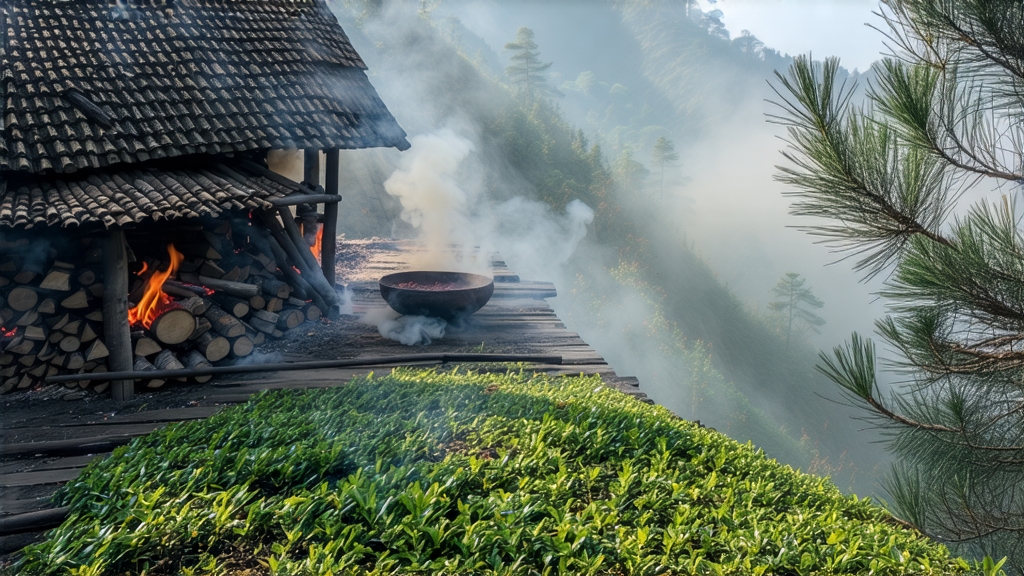
Few teas carry as much myth, aroma, and historical weight as Lapsang Souchong, the original black tea born in the Wuyi Mountains of Fujian Province. To many Western palates the name evokes a campfire in a cup, yet within China it is revered as zhengshan xiaozhong—“small-leaf from the original mountain”—a delicate, sweet, and resinous liquor that predates every other black tea on Earth. Understanding Lapsang Souchong is therefore a journey into both the birth of black tea and the subtle art of balancing smoke with terroir.
History: From Ming-Era Accident to London’s Drawing Rooms
Local legend places the tea’s birth in 1646, when Qing soldiers quartered themselves in Tongmu village during the late Ming chaos. To dry the freshly picked leaves before the troops seized them, farmers rushed the withered leaf over open pine fires. The resulting intensely fragrant tea found favor with Dutch traders at Xiamen port, who shipped it to Amsterdam and later to London, where it became the “bohea” that filled Queen Anne’s cups and inspired the afternoon tea ritual. By the early eighteenth century Lapsang Souchong commanded prices higher than silver, financing caravans along the Tea Horse Road and prompting the British to transplant tea bushes to India in a bid to break China’s monopoly.
Terroir: Why Only Tongmu Can Claim the Name
True zhengshan xiaozhong is produced inside a 600–1,200 m micro-basin carved by the Tongmu River, a tributary of the Nine-Bend Stream that snakes through the Wuyi UNESCO World Heritage site. Here, humid subtropical air collides with mineral-rich granite soils and a 78 % average humidity that nurtures the small-leaf Camellia sinensis var. bohea. The surrounding forest of Masson pine and Chinese fir provides the resinous wood that will later perfume the leaf; without this specific flora, the tea cannot legally bear the “zhengshan” designation. Today only 28 square kilometres are recognised as the core origin, and every kilogram is tracked by the Fujian forestry bureau to deter counterfeits.
Leaf Grades and Styles
Within the protected zone farmers distinguish three grades. The highest, cai cha xiaozhong, uses only the first two leaves and a bud picked before Qingming festival; the delicate needles are lightly withered and smoked for less than three hours, yielding a clear, honey-colored liquor with notes of longan and lychee. Zhong deng xiaozhong incorporates the third leaf, giving a rounder body and subtle cocoa tones. The third grade, lao cong xiaozhong, is harvested from 80- to 120-year-old bushes; thicker leaves withstand longer withering and eight-hour smoking, producing a deeper amber cup with cedar, prune, and a cooling camphor finish. Outside Tongmu, waishan xiaozhong is made with larger-leaf cultivars and industrial smoke tunnels; while pleasant, it lacks the floral lift and mineral backbone of the original.
Craft: The Eight Stages of Pine-Fire Alchemy
- Plucking: Dawn pickings ensure 65 % moisture content, ideal for withering.
- Solar withering: Leaves are spread on bamboo screens for 30–40 minutes of gentle morning sun to initiate enzymatic activity.
- Indoor withering: The leaf is moved to the loft of the wooden tea factory where pine embers smolder below, raising the ambient temperature to 28 °C while smoke is vented away; this stage lasts 4–6 hours until the leaf loses 60 % of its weight and emits a baked apple aroma.
- Rolling: Traditional kneading on rattan trays bruises cells without breaking veins, releasing polyphenols that will later oxidize into theaflavins.
- Oxidation: The rolled leaf rests in deep fir crates covered with wet cloths for 2.5–3 hours; oxidation proceeds slowly in the cool mountain air, turning the leaf a coppery mahogany.
- Pan-firing: A quick 90-second blast at 220 °C halts oxidation, locking in sweet malt notes.
- Smoking: The crucial signature begins when the leaf is spread on multi-tiered bamboo racks suspended 70 cm above slow-burning pine logs. Craftspeople control smoke density by sprinkling water on the embers and rotating the racks every 20 minutes; total smoking